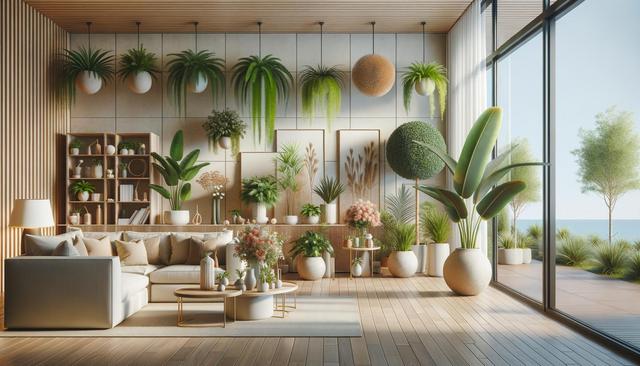
A Guide to Realistic Artificial Plants: Style Without the Stress
Why Artificial Plants Are Gaining Popularity
Artificial plants are becoming an increasingly popular choice for both residential and commercial interiors. Their appeal lies in the combination of visual charm and complete convenience. Unlike live plants, they do not require sunlight, watering, or special attention, making them ideal for individuals with busy schedules or limited gardening experience. Additionally, artificial plants maintain their look year-round, regardless of the season or indoor climate conditions.
For many, the realistic appearance of modern artificial plants is a major draw. Thanks to advancements in materials and production techniques, today’s faux greenery closely mimics natural textures, colors, and even the irregularities of real foliage. This has made it easier than ever to create a lush, green atmosphere without the responsibility of plant care.
Some key reasons why people are switching to artificial plants include:
- They are allergy-friendly and safe for pets.
- No risk of overwatering or under-watering.
- Durable and long-lasting with minimal upkeep.
- Available in a wide variety of styles and sizes to suit any decor.
Choosing the Right Artificial Plant for Your Space
Selecting the right artificial plant involves more than picking one that looks good. Consider the size of the room, the amount of natural light (even though it’s not needed, it affects aesthetics), and your existing interior style. For example, a tall fiddle leaf tree can make a bold statement in a spacious living room, while a set of small succulents might be more appropriate for a desktop or bathroom shelf.
When choosing artificial plants, pay attention to the following details:
- Leaf texture and color variation – Realistic plants often have slight imperfections.
- Pot style – Choose planters that match your decor, whether it’s minimalist, rustic, or modern.
- Material quality – Silk, plastic, or latex-based options offer different levels of realism and durability.
It’s also important to consider scale and proportions. A plant that’s too large can overwhelm a small space, while something too small might get lost in a larger room. Balancing the visual weight of your plant with the surroundings helps create a harmonious design.
Styling Artificial Plants in the Home
Once you’ve selected the right plants, the next step is to incorporate them into your living space in a way that feels natural and intentional. Artificial plants can be used in almost any room, including areas where live plants would struggle to survive, such as windowless bathrooms or dimly lit hallways.
Here are some ideas for styling your artificial greenery effectively:
- Use plant stands or hanging baskets to create visual height and depth.
- Group plants of different sizes and shapes for a layered, organic look.
- Place small faux succulents or herbs on kitchen counters or bookshelves for subtle accents.
- Incorporate artificial vines or trailing plants on shelves or cabinets for a cascading effect.
Remember that even artificial plants benefit from occasional dusting to maintain their fresh appearance. Using a soft cloth or a gentle vacuum attachment can help them stay vibrant and clean.
Artificial Plants in Office and Commercial Spaces
Artificial plants are not just for home use—they’re also a practical and stylish addition to office and commercial environments. In workspaces, they bring a sense of calm and natural beauty, which can help boost mood and productivity. For businesses, they offer a polished look with minimal maintenance.
Popular uses of artificial plants in commercial settings include:
- Reception areas – Large potted plants offer a welcoming first impression.
- Conference rooms – Small tabletop arrangements add life without distraction.
- Retail displays – Greenery enhances the shopping environment and draws attention to products.
- Restaurants and cafes – Faux plants create ambiance without the upkeep of live decor.
One of the major advantages in professional settings is consistency. Unlike live plants, which can wilt or shed, artificial options always look their best. This reliability is especially valuable in public-facing spaces where appearance matters.
Maintenance Tips for Long-Lasting Appeal
While artificial plants require significantly less care than real ones, a little maintenance goes a long way in preserving their realistic appearance. Dust and dirt can accumulate over time, especially in high-traffic areas or near windows, so periodic cleaning is essential.
Helpful maintenance tips include:
- Dust regularly using a microfiber cloth or feather duster.
- For deeper cleans, use a damp cloth with mild soap on plastic leaves.
- Avoid placing artificial plants in direct sunlight to prevent fading.
- Rotate arrangements occasionally to even out exposure and wear.
Storing unused artificial plants properly is also important. Keep them covered and in a dry, cool space to avoid damage from moisture or crushing. With proper care, artificial plants can maintain their vibrant appearance for years, providing a long-term decor solution without ongoing costs or effort.
Conclusion: Effortless Greenery for Every Space
Artificial plants offer a practical and visually appealing way to bring greenery into any environment. Whether you’re decorating a small apartment, a large office, or a commercial venue, they provide the flexibility and style of live plants without the ongoing commitment. With a wide range of lifelike options available, it’s easier than ever to find the perfect piece for your space. By choosing quality designs and following simple maintenance practices, you can enjoy the beauty of nature indoors—effortlessly and year-round.


